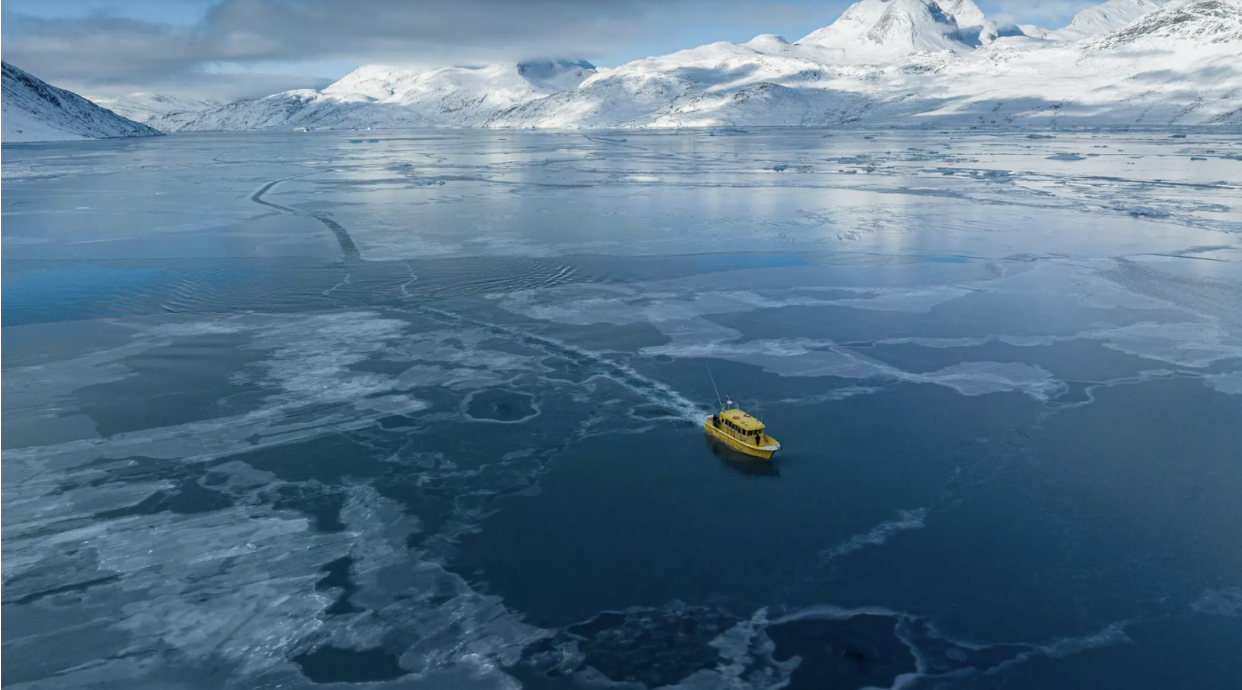Melting Frontiers: Climate Change, Geopolitics, and the Battle for Greenland’s Future
Protesters in Nuuk, Greenland, protest against U.S. President Donald Trump’s proposal to acquire the island. Source: [USA Today]
As the Arctic warms nearly four times faster than the rest of the planet, Greenland has emerged not only as a stark symbol of climate change but also as a focal point of geopolitical ambition and environmental concern. President Donald Trump’s long standing ambition “to claim Greenland” for the United States has evolved from mere rhetoric into an active component of official U.S. policy. What was once dismissed as an outlandish idea or a real estate-style quip has now taken on a serious tone, as the White House begins advancing a formal plan aimed at acquiring the vast Arctic island from Denmark. This shift signals a deeper strategic interest in Greenland’s geopolitical value, particularly its natural resources, military positioning, and relevance in the context of climate change and Arctic sovereignty. The administration’s push has sparked international debate, raised diplomatic tensions with Denmark, and drawn widespread scrutiny over the motivations and implications of such a move.
The island’s rapidly retreating ice sheet is driving sea-level rise, disrupting ecosystems, and transforming the global political map—placing Indigenous communities and fragile environments at the center of a complex web of science, strategy, and sustainability. Simultaneously, global powers are eyeing Greenland’s newly accessible resources and strategic location, raising urgent questions about sustainability, sovereignty, and the ethics of Arctic exploitation.
Rapidly melting ice sheets in Greenland highlight the urgent realities of climate change in the Arctic. Source: [The New York Times]
Greenland’s ice sheet is melting at an unprecedented rate. A study published in Nature earlier this year reveals that the region is losing approximately 250 billion metric tons of ice annually—enough to raise global sea levels by 0.7 millimeters each year. Researchers warn of a “non-linear response” to warming, suggesting that we may be vastly underestimating the pace and magnitude of future melting.
“This is not a distant threat—it’s happening now,” said glaciologist Jason Box from the Geological Survey of Denmark and Greenland. “We are seeing melt rates that were not projected for decades.” New technologies like drones and satellite imaging are also painting a more detailed, and often more alarming, picture. Research highlights the discovery of hidden meltwater channels and under-ice lakes, which may accelerate the disintegration of the ice sheet. “The more we look, the more we realize how dynamic and vulnerable Greenland’s ice really is,” said Columbia University’s Marco Tedesco, who has led several expeditions to the island.
For Greenland’s 56,000 residents—mostly Indigenous Inuit people—the ice is more than a scientific indicator; it is the foundation of their way of life. Melting glaciers disrupt fishing and hunting routes, destabilize coastlines, and pose existential threats to communities that have relied on the Arctic’s rhythms for generations. “Climate change is changing our identity, our traditions,” said Kalaaleq activist Aqqaluk Lynge in a 2023 panel hosted by the Arctic Institute. “It’s not just about the environment—it’s about our culture, our survival.”
Yet, despite the urgency, many Greenlanders are left out of the high-level conversations that determine their future. As global powers eye the island for its resources and strategic location, the voices of those most affected are often sidelined.
In 2019, Trump made international headlines with his proposal to purchase Greenland from Denmark—a move that was swiftly rejected but revealed deeper geopolitical undercurrents. While widely ridiculed at the time, the idea underscored the growing recognition of Greenland’s strategic value. However, his push to buy Greenland from Denmark has continued in his second term to the dismay of Greenlandians and many Americans.
“Trump’s proposal wasn’t just a publicity stunt—it was a signal of U.S. interest in controlling key Arctic assets,” explained Victoria Herrmann, President of The Arctic Institute. “With melting ice opening new shipping routes and exposing untapped reserves of oil, gas, and rare earth minerals, Greenland has become a hotspot for global competition.” Indeed, China has classified itself as a “near-Arctic state” and invested heavily in Arctic infrastructure. Russia, meanwhile, has expanded its military and commercial presence in the region. This rising interest could pose security risks and heighten tensions between global powers.
Trump’s administration has made many trips to Greenland in hopes of convincing the people and government to consider their proposal. Source: [The New York Times]
Melting ice may unlock access to valuable minerals and fossil fuels, but extraction carries steep environmental and ethical risks. According to Eos, Greenland’s subglacial geology holds key insights for energy transitions—yet tapping into those resources could trigger further degradation. “Greenland offers rare earths that are essential for green technologies, but there’s a danger of repeating colonial patterns of resource extraction,” noted Dr. Bo Elberling, a climate scientist at the University of Copenhagen. “We need safeguards that prioritize local rights and environmental limits.”
Meanwhile, the U.S. National Science Foundation emphasizes the importance of collaborative research. “Scientific partnerships in Greenland aren’t just about data—they’re about building equitable relationships with communities and ensuring that knowledge benefits everyone,” said NSF program director Jennifer Mercer. With the Arctic at a tipping point, the stakes in Greenland have never been higher. Climate change, geopolitics, and resource extraction are converging in ways that could either foster cooperation or drive further exploitation. “The future of Greenland depends on decisions made now,” said Tedesco. “We can choose to act responsibly—or we can watch another climate crisis unfold.”
As policymakers, scientists, and citizens grapple with the implications, one thing is clear: protecting Greenland’s ice means protecting not only a region, but the global climate system and the people who have long called it home.



